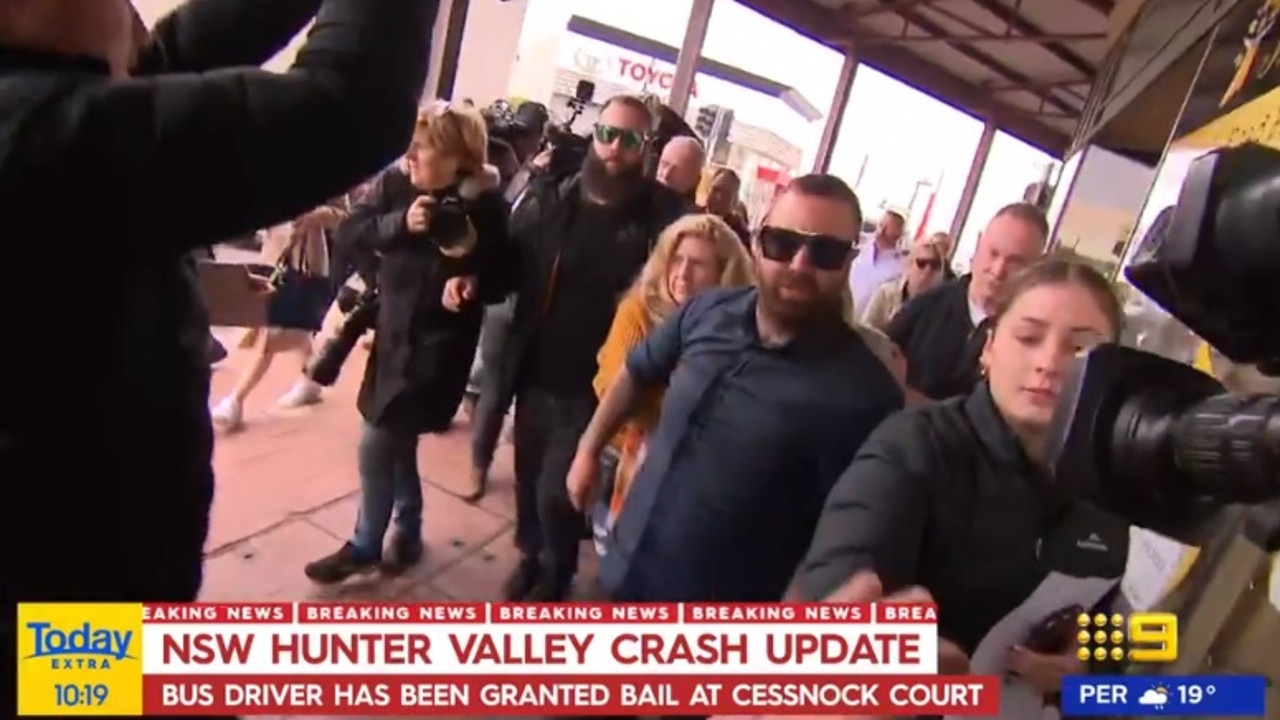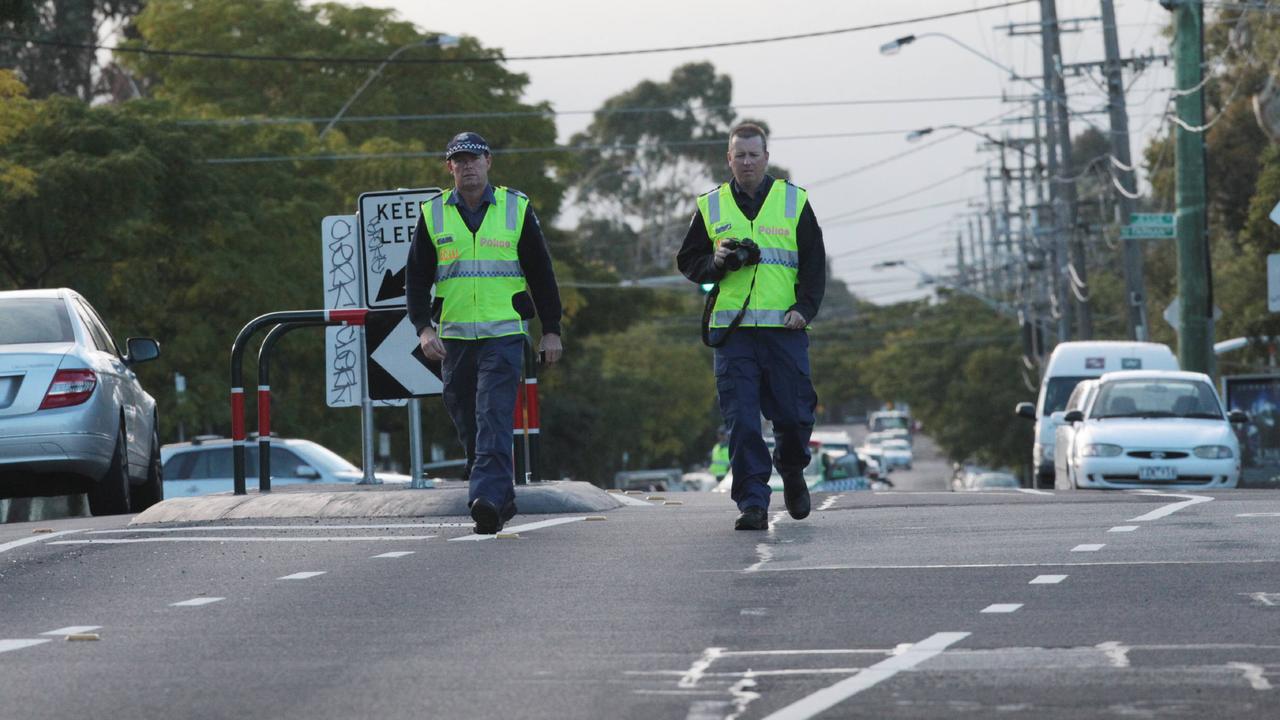A former crash scene investigator says the passengers sitting on the left side in the horrific Hunter Valley wedding bus crash would have sustained catastrophic injuries from coming into contact with the road surface and guard railing.
And anyone standing in the centre or not wearing seatbelts would also have suffered “pretty bad if not fatal injuries” due to the nature of the accident, according to retired Victoria Police officer Peter Bellion.
As bus driver Brett Andrew Button, 58, faced court on Tuesday, questions are growing about why there were so many severe injuries in the rollover on Sunday night that left 10 dead and 25 hospitalised.
The coach was carrying guests who had attended the nuptials of local football star Mitchell Gaffney and Madeleine Edsell at the Wandin Valley Estate, and was en route to nearby Singleton when it rolled just after 11.30pm at a roundabout at Wine Country Drive near the Hunter Expressway off-ramp at Greta.

“It’s a typical heavy vehicle rollover where a heavy vehicle has gone into some sort of turn too fast, it’ll tip over the outside lip,” said Mr Bellion, 58, who retired from Victoria Police in 2016 after suffering post-traumatic stress disorder from seeing more than 2000 fatalities during his 30-year career.
“Obviously the passenger side is coming into contact with the road surface and also the guard railing, they’re sources of contact for anybody inside the vehicle. But then you also have the fact that anybody that’s on the driver side unrestrained, they could also fall to the passenger side and end up with some pretty bad if not fatal injuries.”
He said such accidents highlighted how fragile human beings were.
“Effectively if you look at vulnerability of human impact tolerance, a sudden stop at 30km/h for a human being unrestrained will result in about 15 per cent fatality rate,” he said.
“For a sudden stop of about 40km/h that can result in about a 50 per cent fatality rate, and by the time that gets up to 50km/h, 85 per cent would be a fatal outcome.”

Whether or not passengers were wearing seatbelts would form a major part of the investigation, according to Mr Bellion, who said he “can’t confirm or deny but I’d suspect that’s most probably” a contributor to the high number of deaths.
He added, “In a rollover, obviously the main region that succumbs to injuries is head and upper body, so any time you’re standing in a rollover event there’s going to be more forces involved.”
Survivors and close friends said multiple passengers had expressed concern about the speed of the bus throughout the trip, and had urged others to return to their seats for safety.
Mr Button, who was charged with 10 counts of dangerous driving occasioning death and one count of negligent driving, allegedly said “fasten your seatbelt” to passengers just before the fatal moment, Cessnock Local Court heard on Tuesday.
The Daily Telegraph earlier reported that witnesses alleged Mr Button boasted to those on board through the internal microphone moments before losing control, “If you think that was fast … watch this.”

NSW Police Acting Assistant Commissioner David Waddell alleged the bus driver was travelling too fast.
“He entered that roundabout driving in a manner that was inconsistent with the conditions,” he alleged to reporters on Tuesday morning.
“Obviously the speed was too quick for him to negotiate that roundabout, causing the vehicle to fall onto its left side and cause those injuries.”
Emergency services, including ambulance services, NSW Fire and Rescue, the NSW Rural Fire Service, NSW Police and Highway Patrol rushed to the site.
Mr Waddell said it was a “very chaotic scene” and “some of our police are visibly distraught”.
“It’s a traumatic event for all the family, all the friends, from what was a wedding where people come from wide and far,” he said. “The passengers range from 20s to 60s, males and females, local and interstate as you’d expect.”
Mr Bellion explained that in these scenarios, medical evacuation of any survivors was obviously the first priority but “if they’re deceased, you can’t do anything, they’re left in situ for investigators to document where they’ve finished and what happened to them”.

Investigators will then note down basic facts such as weather, road and lighting conditions, before conducting a scene investigation collecting physical evidence like road surface friction, the vehicle itself and the design of the roundabout including signs on approach.
“Then you’re getting into your third level which is the technical accident investigation side, which is basically where they’d be at this stage,” Mr Bellion said.
“Making estimates of velocity based on tyre marks, doing mechanical inspections, downloading on-board monitoring systems, more detailed inspections of each and every seatbelt in the bus — has it been cut and rescue or worn and showing signs of loading marks on the different connection points.”
The medical examination side would also include autopsy to determine “what injury caused the death and any telltale signs or evidence of seatbelt-wearing”.
“Then from your survivors you’re going to establish a seating plan,” he said. “That takes quite some time. It really takes a lot of work to establish who was in what seat.”

Mr Bellion likened it to one of his worst cases, the 1993 Wangaratta crash, when a semi-trailer collided with a coach on the Hume Highway killing nine people and injuring 35.
He was one of several experts who gave evidence in Canberra, leading to the introduction of mandatory seatbelts in coaches.
“The problem is ultimately if they’re not worn they’re useless,” he said.
NSW Health Minister Ryan Park said it was a “horrendous set of circumstances” that the local community would be dealing with long after the “lights and sirens and cameras go”.
“That’s why I want to make sure the mental health support is provided within the community for as long as we need it there,” he told Seven’s Sunrise on Tuesday.
“We are here for the long haul as this community attempts to rebuild.”
Mr Park said the injured were “going well as can be expected” and NSW hospitals were coping “very well, given the circumstances”.
“But our frontline clinicians, what they experienced at the scene was horrendous,” he said.
“I spoke to a paramedic last night and he said it’s the most devastating scene he’s been to in 15 years on the job. I don’t think any of us can imagine what that scene would be like or what those experiences for the frontline paramedics are.”

Mr Park said for the emergency workers it was a “horrific scene and one that I know they will never forget, but the way in which they carried out their task, I’m very proud of them as their Minister and I know the community would be very proud of them as well”.
“The community will need support and so too our frontline workers and we want them to get that support so they can debrief, discuss and comprehend what they’ve been involved in,” he said.
Mr Bellion warned that the psychological effects could take years to manifest.
He was also on the scene of the 2007 Kerang disaster, in which 11 people were killed an 23 injured when a semi-trailer struck the second and third carriages of a V/Line passenger train at a level crossing.
“Those two jobs in particular, some of the nightmares from them were just horrific,” he said.
“Effectively the inside of the coach at Wangaratta, and the second carriage at Kerang, were like bomb scenes. The level of destruction that had gone on in there, it’s fairly confronting stuff you’re seeing.”

He “still kept going” after Wangaratta but it wasn’t until Kerang, 14 years later, that he began to experience full-blown PTSD.
“The second day at Kerang, I couldn’t explain how I felt … it was surreal,” he said.
“I came back on the Thursday, walked into my home with the kids there and I basically broke down. I’ve ended up with 35 per cent of the brain affected by the road trauma I’ve attended, I’ve got more than 20 per cent of my body with psoriasis from the cortisol and adrenaline.”
Mr Bellion said his advice for any first responders involved in the Hunter Valley crash was not to “box up” their emotions.
“It’s important to talk and let those emotions release from within,” he said.
“It’s better to do that than try and self-medicate with things like alcohol or recreational drugs to try and combat the highs and lows of what you’re experiencing. Go through the proper medical channels.”


Leave a Reply